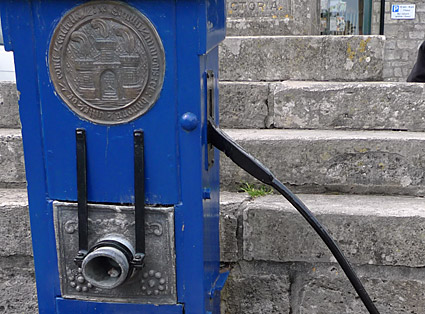Corfe Castle Dorset
Our walk takes us into Corfe Castle for lunch and a steam train!
(Photos/words © urban75, 15th-16th May, 2009)
Dominated by its one thousand year-old castle, Corfe Castle is a stunningly attractively village, virtually unspoiled by modern development.

The name 'Corfe' is derived from the Saxon word for gap, and the village sits in the Isle of Purbeck.
Archaeological digs around the common of Corfe Castle have unearthed burial mounds suggesting that there's been human activity here from 6000BC.

A view of Corfe Castle from a similar viewpoint in 1643.

There's also evidence of a later Celtic field system worked by the Durotriges tribe who traded with the Romans after the Roman invasion c. 50AD.
Here we're walking through a field of buttercups towards the centre of the village.

The 1796 Corfe Castle Census revealed that there were 96 men working in local industries and living in the town, over half of them clay cutters working in the nearby pits at Norden.
These supplied Purbeck Ball Clay to the legendary Josiah Wedgwood and other pottery manufacturers. The clay extraction industry continued as a major employer up until the 20th century.

Almost all of the buildings in the village are constructed with the local grey Purbeck limestone, which adds a lovely timeless quality to this view.

The Church of St. Edward The Martyr, reputed to have been built on the site of a blind woman's cottage where Edward's body was brought after his murder.
The original 13th century church had fallen into such disrepair by the 1800s that it was completely rebuilt, with only the original tower remaining.


The Fox Inn in Corfe Castle, claimed to be the oldest pub in the village, dating from 1568.

The smallest town hall in England.

On the ground floor of the Town Hall is a diminutive museum.

Dinosaur footprints!

The centre of the village.
Corfe castle is a small village, comprising just two main streets, East Street and West Street, linked at their north end at the Square.


The fine lines of the Bankes Arms Hotel, originally built in 1549.

The various shields of the Constables of Corfe Castle.

The water pump in the centre of the town.

Water pump detail.

Sign commemorating Edward The Martyr King of Wessex who was 'Treacherously stabbed at Corves Gate in AD978 by his stepmother Elfrida.'

Back of the sign, with the cryptic words, 'The Gift Of Four - JRN, EBD, GDD and FHN.'


It's a stunningly pretty village.

The village Post Office, a fortunate survivor of the disgraceful programme of wholesale closures around the UK in recent years.

Village rooftops. The tiny dots on the top of the hill are hikers!

Centre of Corfe castle village.

« Walk homepage Part three: picnic by Corfe Castle »
|

